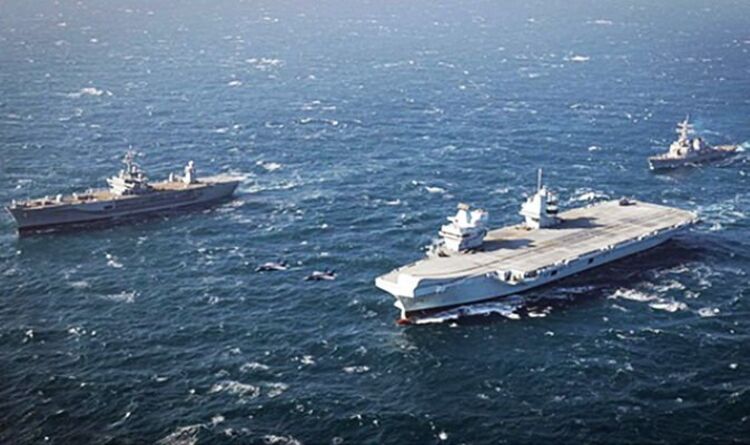Putin on alert as Royal Navy’s biggest warship joins fleet of 25 NATO vessels in Arctic
HMS Prince of Wales: Royal Navy takes command in Portsmouth
We use your sign-up to provide content in ways you’ve consented to and to improve our understanding of you. This may include adverts from us and 3rd parties based on our understanding. You can unsubscribe at any time. More info
With over 30,000 troops and multiple hardware assets shipped to the sub-zero temperatures of the northern parts of Europe, the training exercise dubbed “Cold Response” is a bi-annual event with significant timing this year. British assets will be joining a 27-nation operation just a few hundred kilometres from the Russian border as the invasion of Ukraine approaches its third week. Fresh from training alongside UK F-35B Lightning jets, HMS Prince of Wales, sailed north for Exercise Cold Response, a month-long test by land, sea and air of allied forces.
An 11-nation-strong task force descended just off the Norwegian coast at the start of the training, which will show how a unified force would defend Norway and Europe’s northern flank from a modern adversary.
The exercise will simulate the response NATO would provide should a fellow alliance partner be attacked, reflecting the “Collective Defence” under Article 5 of the agreement between the member states.
Speaking on behalf of the Royal Navy about the deployment, as well as the prospect of working with partners, Lieutenant Si Clark said: “It’s a really exciting position to be the link between the jets and the ship.
“Although we don’t have them currently embarked, being able to control the jets during their training is a really rewarding role on HMS Prince of Wales.”


The Royal Navy said on its website: “The F-35B jets were pitted against eight ‘aggressor’ aircraft, allowing them to hone tactics between ship and fighter jets.
“Typhoon jets were also involved as well as Hawks from 100 Squadron at RAF Leeming.
“As Prince of Wales continued her journey north to the Arctic, the RAF’s 207 Squadron carried out a flypast with two of their F-35B jets while the aircraft carrier sailed alongside USS Mount Whitney and USS The Sullivans.”
Commander Mark Sparrow Royal Navy, Officer Commanding 617 Squadron, said: “Today was a fantastic opportunity to exercise with HMS Prince of Wales testing out our air-maritime integration tactics as well as 5th and 4th Generation integration between Lightning and Typhoon.
“Having spent seven months with HMS Queen Elizabeth on Carrier Strike Group 21,it was great for 617 Squadron to be able to work with HMS Prince of Wales for the first time as she hones her skills as a command ship for NATO.
“The air defence exercise was a great success proving the interoperability between air and sea.”


Prince of Wales is responsible for leading NATO’s Maritime High Readiness Force – an international task group formed to deal with major global events – and deploys for the first time in that role to Cold Response.
Aboard the carrier is the most senior sea-going staff in the Royal Navy – Commander UK Strike Force, headed by Rear Admiral Mike Utley, who will lead a sizeable task force as part of a galvanised NATO effort for peace and stability in Europe.
Alongside landing support ship RFA Mounts Bay, HMS Albion leads the UK’s amphibious input into Cold Response, with “a significant level” of littoral strike operations – traditional-style commando raids – staged in the fjords, with the British force integrating with numerous allies.
Around 900 Royal Marines have been deployed to the Arctic since January in preparation for the exercises, sharpening their expertise in operating in freezing conditions.
DON’T MISS:
Kim humiliates Putin after Russia begs for help [REPORT]
‘Russia on run!’ Putin’s given just TEN days to survive [REVEAL]
US ‘dragon’ spy plane lands at RAF base [INSIGHT]

While Prince of Wales works on Cold Response, her sister ship HMS Queen Elizabeth is carrying out vital training and exercises in the waters close to the UK to keep her ready for operations anywhere in the world.
So far, NATO has agreed not to intervene directly in the ongoing war.
Should NATO become more involved in the ongoing crisis in Ukraine? Has Putin underestimated his ambitions over Ukraine? Should a no-fly zone be imposed above Ukraine? Let us know your thoughts on these questions by CLICKING HERE and joining the debate in our comments section below – Every Voice Matters!

Calls by Ukraine to set up a no-fly zone above the country have been largely snubbed by Western powers as concerns of such moves could lead to an expansion of the war into mainland Europe.
Reports suggest Russia is stepping up its assault on Ukraine, with missile strikes hitting Lviv in recent days, a mere 30km from the border of Poland, itself a NATO member.
Source: Read Full Article



